The Cambridge History of Japan, Vol. 4: Early Modern Japan
Подождите немного. Документ загружается.

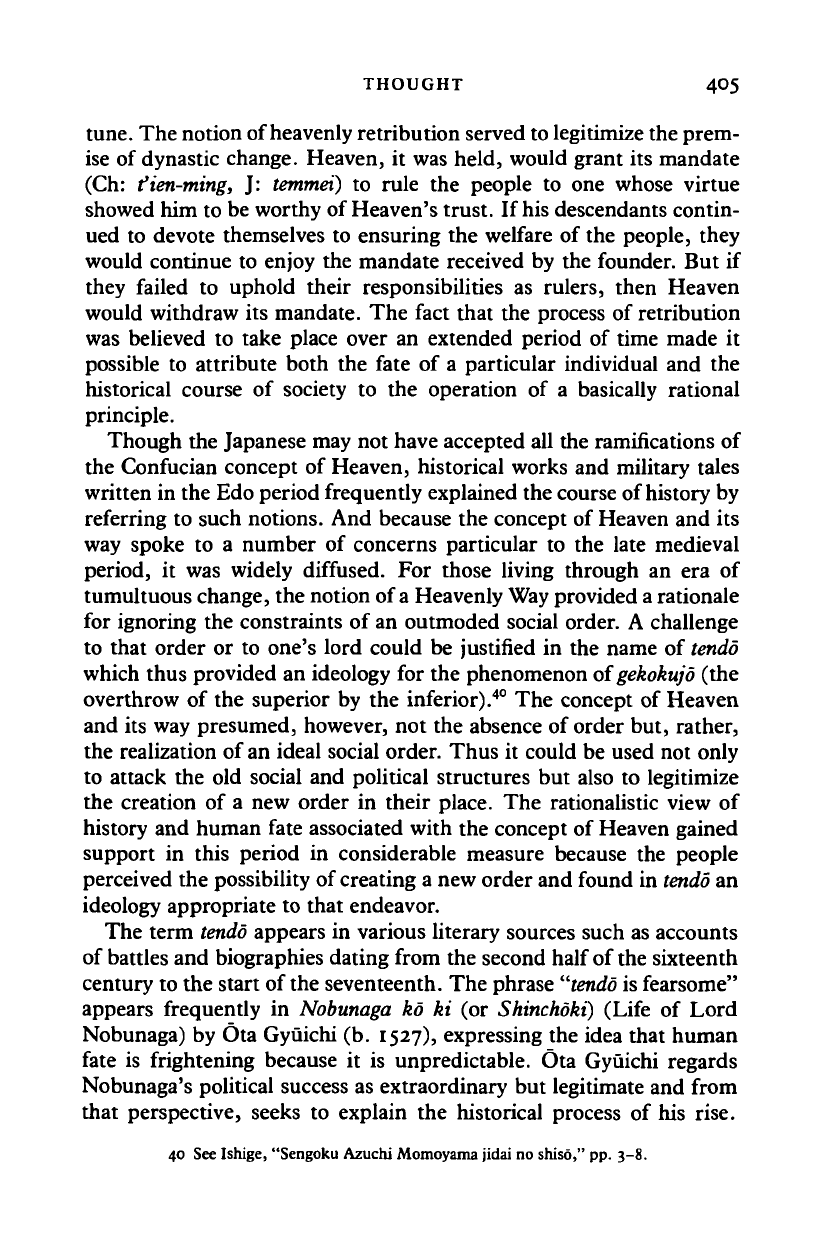
THOUGHT 405
tune.
The notion of heavenly retribution served to legitimize the prem-
ise of dynastic change. Heaven, it was held, would grant its mandate
(Ch: fien-ming, J:
tentmei)
to rule the people to one whose virtue
showed him to be worthy of Heaven's trust. If
his
descendants contin-
ued to devote themselves to ensuring the welfare of the people, they
would continue to enjoy the mandate received by the founder. But if
they failed to uphold their responsibilities as rulers, then Heaven
would withdraw its mandate. The fact that the process of retribution
was believed to take place over an extended period of time made it
possible to attribute both the fate of a particular individual and the
historical course of society to the operation of a basically rational
principle.
Though the Japanese may not have accepted all the ramifications of
the Confucian concept of Heaven, historical works and military tales
written in the Edo period frequently explained the course of history by
referring to such notions. And because the concept of Heaven and its
way spoke to a number of concerns particular to the late medieval
period, it was widely diffused. For those living through an era of
tumultuous change, the notion of a Heavenly Way provided
a
rationale
for ignoring the constraints of an outmoded social order. A challenge
to that order or to one's lord could be justified in the name of
tendo
which thus provided an ideology for the phenomenon of
gekokujo
(the
overthrow of the superior by the inferior).
40
The concept of Heaven
and its way presumed, however, not the absence of order but, rather,
the realization of an ideal social order. Thus it could be used not only
to attack the old social and political structures but also to legitimize
the creation of a new order in their place. The rationalistic view of
history and human fate associated with the concept of Heaven gained
support in this period in considerable measure because the people
perceived the possibility of creating a new order and found in
tendo
an
ideology appropriate to that endeavor.
The term
tendo
appears in various literary sources such as accounts
of battles and biographies dating from the second half of the sixteenth
century to the start of
the
seventeenth. The phrase
"tendo
is fearsome"
appears frequently in
Nobunaga
ko ki (or Shinchoki) (Life of Lord
Nobunaga) by Ota Gyuichi (b. 1527), expressing the idea that human
fate is frightening because it is unpredictable. Ota Gyuichi regards
Nobunaga's political success as extraordinary but legitimate and from
that perspective, seeks to explain the historical process of his rise.
40 See Ishige, "Sengoku Azuchi Momoyama jidai no shisd," pp. 3-8.
Cambridge Histories Online © Cambridge University Press, 2008
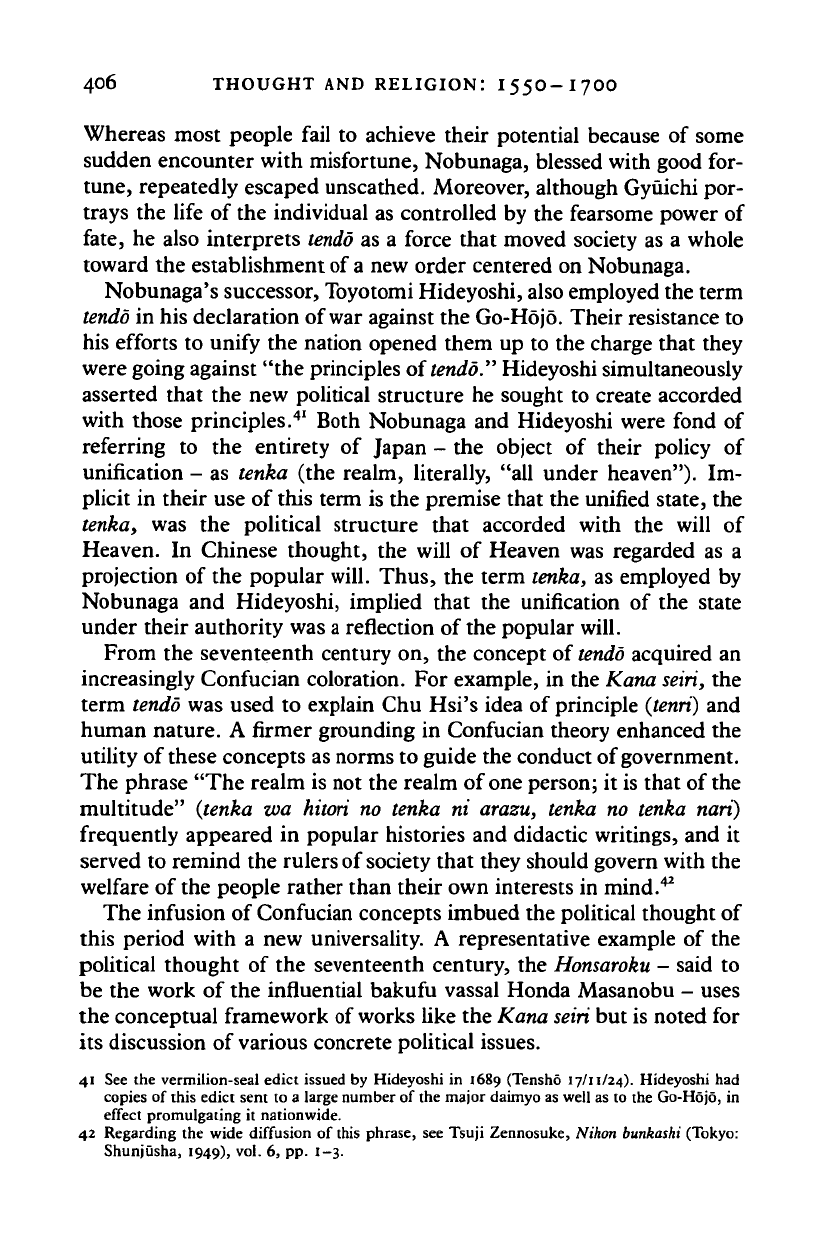
406 THOUGHT AND RELIGION: I55O-I7OO
Whereas most people fail to achieve their potential because of some
sudden encounter with misfortune, Nobunaga, blessed with good for-
tune,
repeatedly escaped unscathed. Moreover, although Gyuichi por-
trays the life of the individual as controlled by the fearsome power of
fate,
he also interprets
tendo
as a force that moved society as a whole
toward the establishment of
a
new order centered on Nobunaga.
Nobunaga's successor, Toyotomi Hideyoshi, also employed the term
tendo
in his declaration of war against the Go-Hojo. Their resistance to
his efforts to unify the nation opened them up to the charge that they
were going against "the principles of
tendo."
Hideyoshi simultaneously
asserted that the new political structure he sought to create accorded
with those principles.
41
Both Nobunaga and Hideyoshi were fond of
referring to the entirety of Japan - the object of their policy of
unification - as tenka (the realm, literally, "all under heaven"). Im-
plicit in their use of this term is the premise that the unified state, the
tenka, was the political structure that accorded with the will of
Heaven. In Chinese thought, the will of Heaven was regarded as a
projection of the popular will. Thus, the term
tenka,
as employed by
Nobunaga and Hideyoshi, implied that the unification of the state
under their authority was
a
reflection of the popular will.
From the seventeenth century on, the concept of
tendo
acquired an
increasingly Confucian coloration. For example, in the Kana
seiri,
the
term
tendo
was used to explain Chu Hsi's idea of principle
(tenri)
and
human nature. A firmer grounding in Confucian theory enhanced the
utility of these concepts as norms to guide the conduct of government.
The phrase "The realm is not the realm of
one
person; it is that of the
multitude" (tenka wa hitori no tenka ni arazu, tenka no tenka nan)
frequently appeared in popular histories and didactic writings, and it
served to remind the rulers of society that they should govern with the
welfare of the people rather than their own interests in mind.
42
The infusion of Confucian concepts imbued the political thought of
this period with a new universality. A representative example of the
political thought of the seventeenth century, the
Honsaroku
- said to
be the work of the influential bakufu vassal Honda Masanobu - uses
the conceptual framework of works like the Kana
seiri
but is noted for
its discussion of various concrete political issues.
41 See the vermilion-seal edict issued by Hideyoshi in 1689 (Tensho 17/11/24). Hideyoshi had
copies of this edict sent to a large number of the major daimyo as well as to the Go-Hojo, in
effect promulgating it nationwide.
42 Regarding the wide diffusion of this phrase, see Tsuji Zennosuke, Nihon
bunkashi
(Tokyo:
Shunjusha, 1949), vol. 6, pp. 1-3.
Cambridge Histories Online © Cambridge University Press, 2008
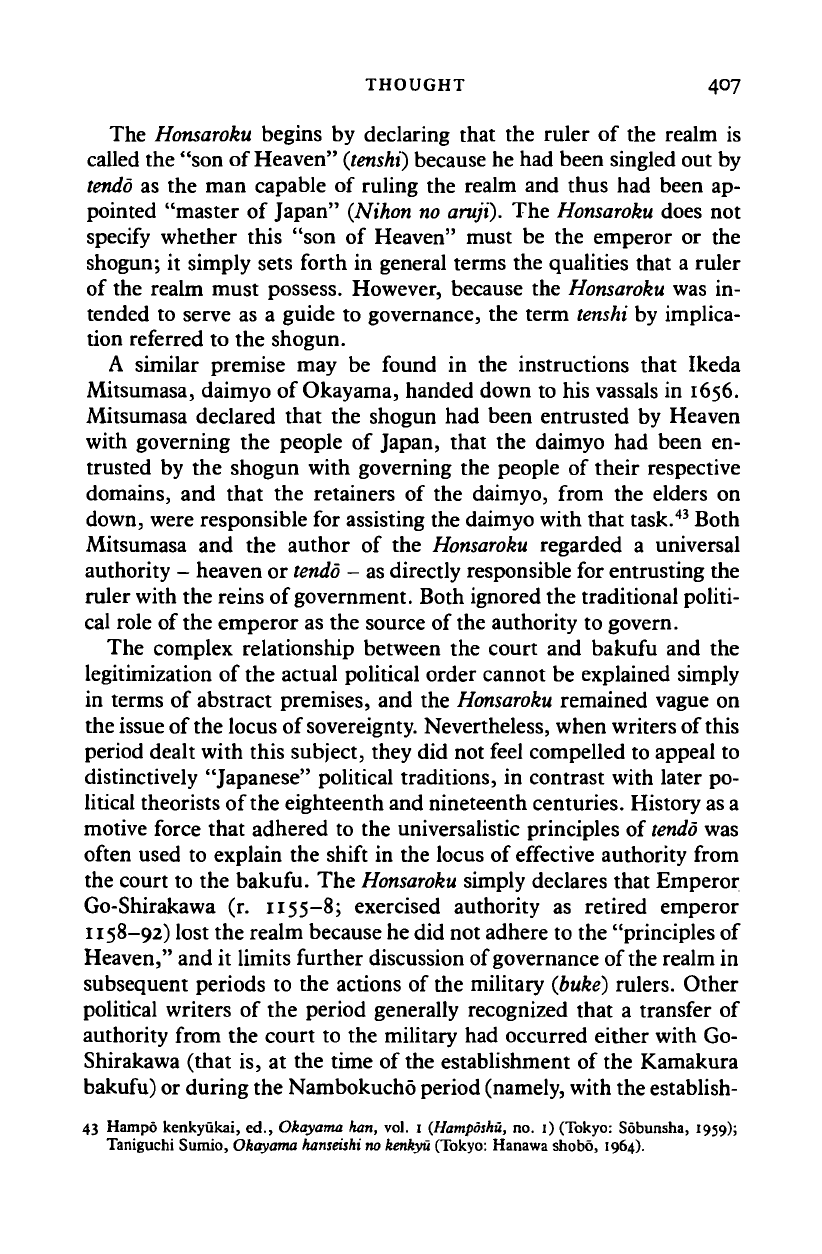
THOUGHT 407
The
Honsaroku
begins by declaring that the ruler of the realm is
called the "son of Heaven"
(tenshi)
because he had been singled out by
tendo
as the man capable of ruling the realm and thus had been ap-
pointed "master of Japan" (Nihon no
aruji).
The
Honsaroku
does not
specify whether this "son of Heaven" must be the emperor or the
shogun; it simply sets forth in general terms the qualities that a ruler
of the realm must possess. However, because the
Honsaroku
was in-
tended to serve as a guide to governance, the term
tenshi
by implica-
tion referred to the shogun.
A similar premise may be found in the instructions that Ikeda
Mitsumasa, daimyo of Okayama, handed down to his vassals in 1656.
Mitsumasa declared that the shogun had been entrusted by Heaven
with governing the people of Japan, that the daimyo had been en-
trusted by the shogun with governing the people of their respective
domains, and that the retainers of the daimyo, from the elders on
down, were responsible for assisting the daimyo with that task.
43
Both
Mitsumasa and the author of the
Honsaroku
regarded a universal
authority - heaven or
tendo
- as directly responsible for entrusting the
ruler with the reins of government. Both ignored the traditional politi-
cal role of the emperor as the source of the authority to govern.
The complex relationship between the court and bakufu and the
legitimization of the actual political order cannot be explained simply
in terms of abstract premises, and the
Honsaroku
remained vague on
the issue of
the
locus of sovereignty. Nevertheless, when writers of this
period dealt with this subject, they did not feel compelled to appeal to
distinctively "Japanese" political traditions, in contrast with later po-
litical theorists of the eighteenth and nineteenth centuries. History as
a
motive force that adhered to the universalistic principles of
tendo
was
often used to explain the shift in the locus of effective authority from
the court to the bakufu. The
Honsaroku
simply declares that Emperor
Go-Shirakawa (r. 1155-8; exercised authority as retired emperor
1158-92) lost the realm because he did not adhere to the "principles of
Heaven," and it limits further discussion of governance of the realm in
subsequent periods to the actions of the military
(buke)
rulers. Other
political writers of the period generally recognized that a transfer of
authority from the court to the military had occurred either with Go-
Shirakawa (that is, at the time of the establishment of the Kamakura
bakufu) or during the Nambokucho period (namely, with the establish-
43 Hampo kenkyukai, ed., Okayama han, vol. i (Hamposhu, no. i) (Tokyo: Sobunsha, 1959);
Taniguchi Sumio, Okayama hanseishi no kenkyu (Tokyo: Hanawa shobo, 1964).
Cambridge Histories Online © Cambridge University Press, 2008
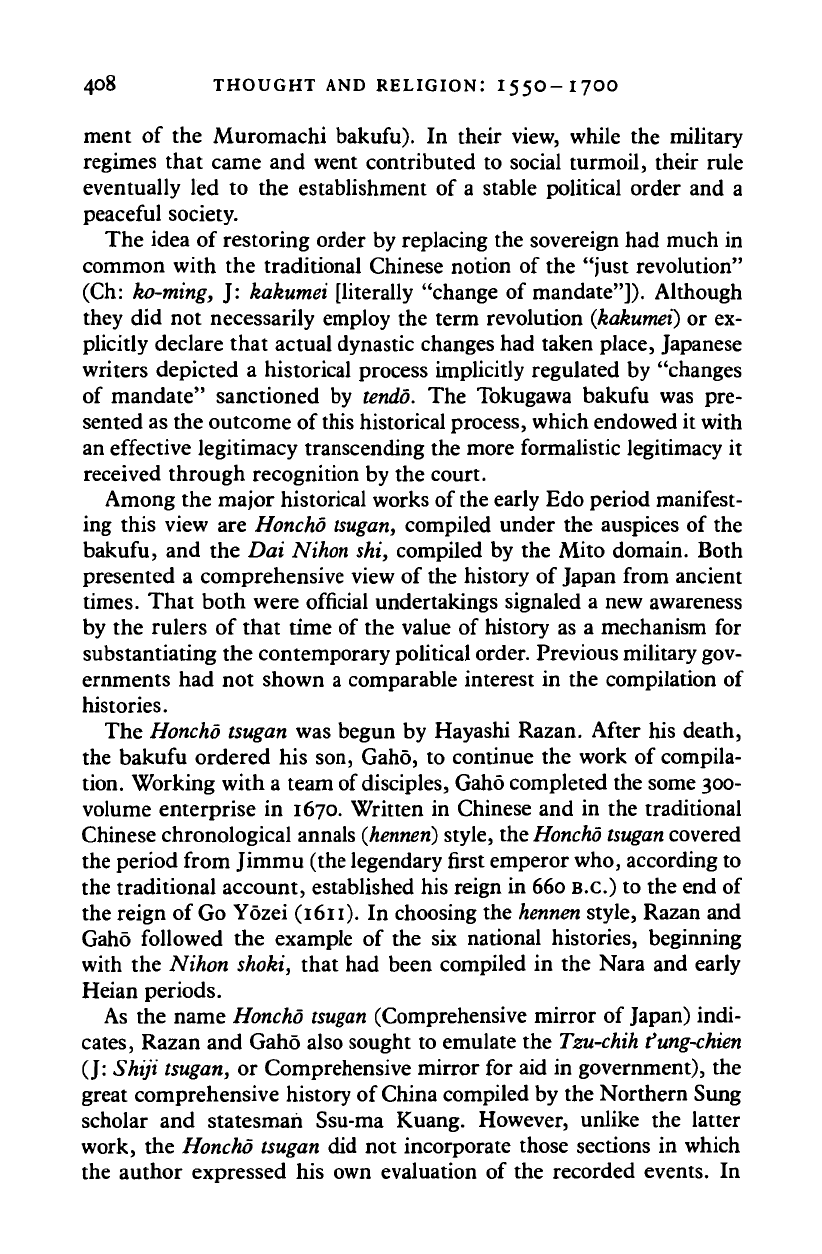
408 THOUGHT AND RELIGION: I55O-17OO
ment of the Muromachi bakufu). In their view, while the military
regimes that came and went contributed to social turmoil, their rule
eventually led to the establishment of a stable political order and a
peaceful society.
The idea of restoring order by replacing the sovereign had much in
common with the traditional Chinese notion of the "just revolution"
(Ch: ko-ming, J: kakumei [literally "change of mandate"]). Although
they did not necessarily employ the term revolution
{kakumei)
or ex-
plicitly declare that actual dynastic changes had taken place, Japanese
writers depicted a historical process implicitly regulated by "changes
of mandate" sanctioned by tendo. The Tokugawa bakufu was pre-
sented as the outcome of
this
historical process, which endowed it with
an effective legitimacy transcending the more formalistic legitimacy it
received through recognition by the court.
Among the major historical works of the early Edo period manifest-
ing this view are
Honcho
tsugan,
compiled under the auspices of the
bakufu, and the Dai Nihon shi, compiled by the Mi to domain. Both
presented a comprehensive view of the history of Japan from ancient
times.
That both were official undertakings signaled a new awareness
by the rulers of that time of the value of history as a mechanism for
substantiating the contemporary political order. Previous military gov-
ernments had not shown a comparable interest in the compilation of
histories.
The
Honcho tsugan
was begun by Hayashi Razan. After his death,
the bakufu ordered his son, Gaho, to continue the work of compila-
tion. Working with a team of disciples, Gaho completed the some 300-
volume enterprise in 1670. Written in Chinese and in the traditional
Chinese chronological annals
(henneri)
style, the
Honcho tsugan
covered
the period from Jimmu (the legendary first emperor who, according to
the traditional account, established his reign in 660 B.C.) to the end of
the reign of Go Yozei (1611). In choosing the
hennen
style, Razan and
Gaho followed the example of the six national histories, beginning
with the Nihon shoki, that had been compiled in the Nara and early
Heian periods.
As the name
Honcho tsugan
(Comprehensive mirror of Japan) indi-
cates,
Razan and Gaho also sought to emulate the
Tzu-chih fung-chien
(J: Shiji
tsugan,
or Comprehensive mirror for aid in government), the
great comprehensive history of China compiled by the Northern Sung
scholar and statesman Ssu-ma Kuang. However, unlike the latter
work, the
Honcho tsugan
did not incorporate those sections in which
the author expressed his own evaluation of the recorded events. In
Cambridge Histories Online © Cambridge University Press, 2008
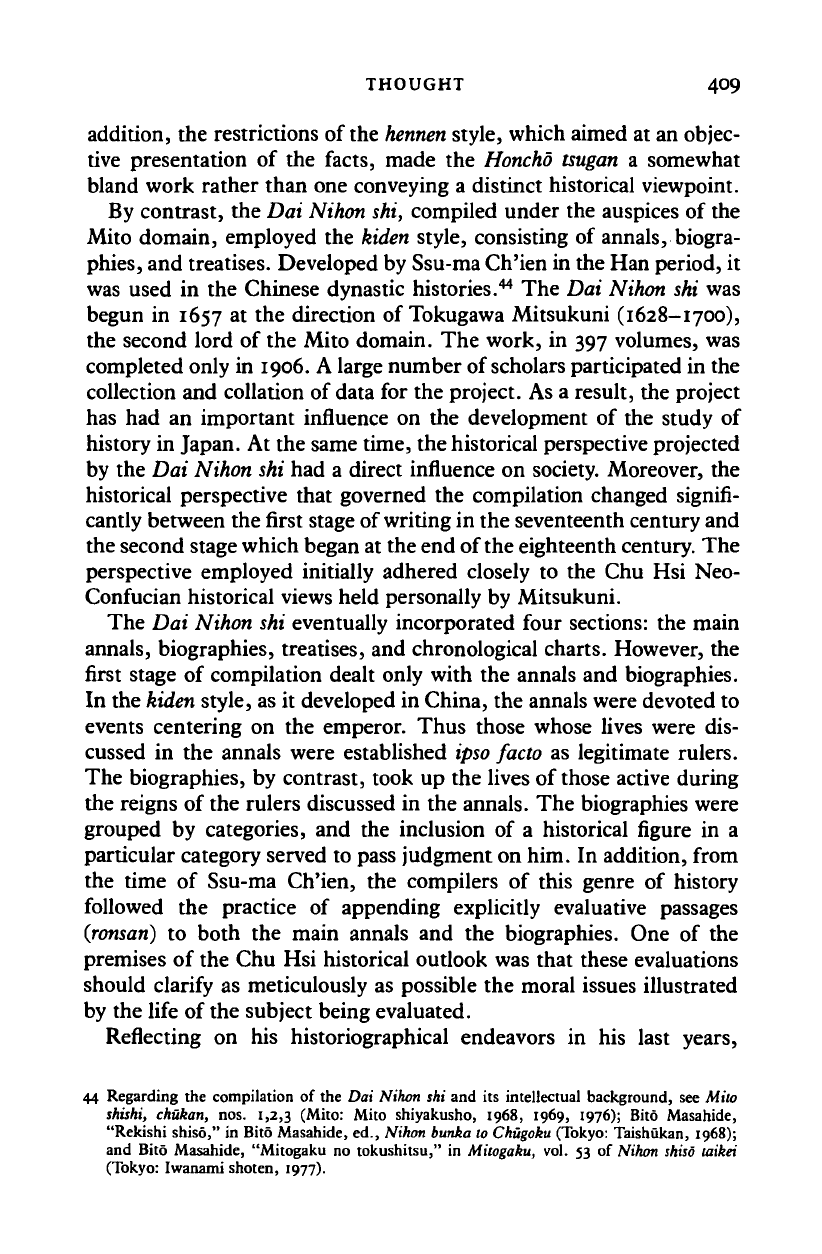
THOUGHT 409
addition, the restrictions of the
hennen
style, which aimed at an objec-
tive presentation of the facts, made the
Honcho tsugan
a somewhat
bland work rather than one conveying a distinct historical viewpoint.
By contrast, the Dai Nihon
shi,
compiled under the auspices of the
Mito domain, employed the
kiden
style, consisting of annals, biogra-
phies,
and treatises. Developed by Ssu-ma Ch'ien in the Han period, it
was used in the Chinese dynastic histories.
44
The Dai Nihon shi was
begun in 1657 at the direction of Tokugawa Mitsukuni (1628-1700),
the second lord of the Mito domain. The work, in 397 volumes, was
completed only in 1906. A large number of scholars participated in the
collection and collation of data for the project. As a result, the project
has had an important influence on the development of the study of
history in Japan. At the same time, the historical perspective projected
by the Dai Nihon shi had a direct influence on society. Moreover, the
historical perspective that governed the compilation changed signifi-
cantly between the first stage of writing in the seventeenth century and
the second stage which began at the end of the eighteenth century. The
perspective employed initially adhered closely to the Chu Hsi Neo-
Confucian historical views held personally by Mitsukuni.
The Dai Nihon shi eventually incorporated four sections: the main
annals, biographies, treatises, and chronological charts. However, the
first stage of compilation dealt only with the annals and biographies.
In the
kiden
style, as it developed in China, the annals were devoted to
events centering on the emperor. Thus those whose lives were dis-
cussed in the annals were established
ipso
facto as legitimate rulers.
The biographies, by contrast, took up the lives of those active during
the reigns of the rulers discussed in the annals. The biographies were
grouped by categories, and the inclusion of a historical figure in a
particular category served to pass judgment on him. In addition, from
the time of Ssu-ma Ch'ien, the compilers of this genre of history
followed the practice of appending explicitly evaluative passages
(ronsan)
to both the main annals and the biographies. One of the
premises of the Chu Hsi historical outlook was that these evaluations
should clarify as meticulously as possible the moral issues illustrated
by the life of the subject being evaluated.
Reflecting on his historiographical endeavors in his last years,
44 Regarding the compilation of the Dai Nihon shi and its intellectual background, see Mito
shishi, chukan, nos. 1,2,3 (Mito: Mito shiyakusho, 1968, 1969, 1976); Bito Masahide,
"Rekishi shiso," in Bito Masahide, ed., Nihon bunka to
Chugoku
(Tokyo: Taishukan, 1968);
and Bito Masahide, "Mitogaku no tokushitsu," in Mitogaku, vol. 53 of Nihon shiso taikei
(Tokyo: Iwanami shoten, 1977).
Cambridge Histories Online © Cambridge University Press, 2008
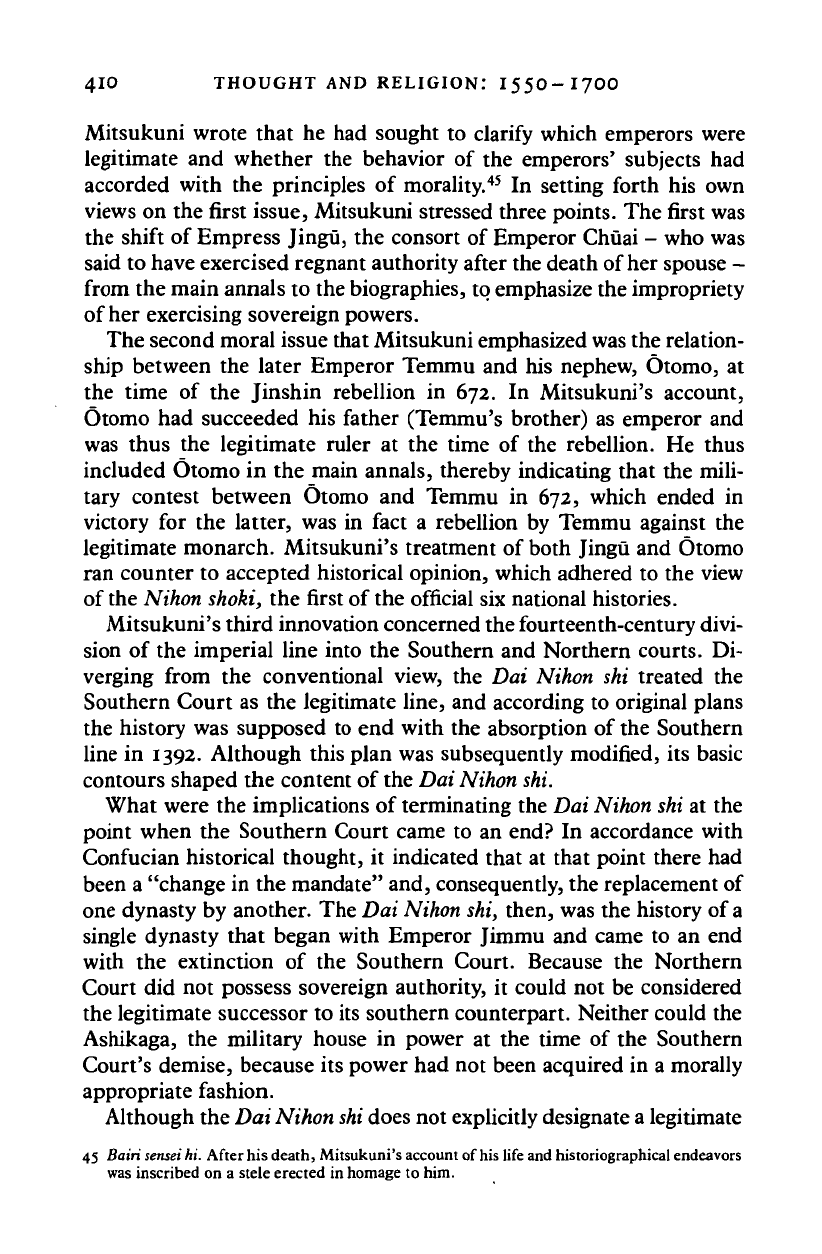
410 THOUGHT AND RELIGION: I55O-I7OO
Mitsukuni wrote that
he had
sought
to
clarify which emperors were
legitimate
and
whether
the
behavior
of the
emperors' subjects
had
accorded with
the
principles
of
morality.
45
In
setting forth
his own
views
on the
first issue, Mitsukuni stressed three points.
The
first
was
the shift
of
Empress Jingu,
the
consort
of
Emperor Chuai
-
who was
said to have exercised regnant authority after the death of her spouse
-
from the main annals to the biographies, to emphasize the impropriety
of her exercising sovereign powers.
The second moral issue that Mitsukuni emphasized
was
the relation-
ship between
the
later Emperor Temmu
and his
nephew, Otomo,
at
the time
of the
Jinshin rebellion
in 672. In
Mitsukuni's account,
Otomo
had
succeeded
his
father (Temmu's brother)
as
emperor
and
was thus
the
legitimate ruler
at the
time
of the
rebellion.
He
thus
included Otomo
in the
main annals, thereby indicating that
the
mili-
tary contest between Otomo
and
Temmu
in 672,
which ended
in
victory
for the
latter, was
in
fact
a
rebellion
by
Temmu against
the
legitimate monarch. Mitsukuni's treatment
of
both Jingu
and
Otomo
ran counter
to
accepted historical opinion, which adhered
to
the view
of the Nihon shoki,
the
first
of
the official six national histories.
Mitsukuni's third innovation concerned the fourteenth-century divi-
sion
of
the imperial line into
the
Southern
and
Northern courts.
Di-
verging from
the
conventional view,
the Dai
Nihon
shi
treated
the
Southern Court
as the
legitimate line, and according
to
original plans
the history was supposed
to end
with
the
absorption
of
the Southern
line
in
1392. Although this plan was subsequently modified,
its
basic
contours shaped the content
of
the Dai Nihon shi.
What were the implications
of
terminating the Dai Nihon shi
at the
point when
the
Southern Court came
to an
end?
In
accordance with
Confucian historical thought,
it
indicated that
at
that point there
had
been
a
"change in the mandate" and, consequently, the replacement of
one dynasty
by
another. The Dai Nihon
shi,
then, was the history
of
a
single dynasty that began with Emperor Jimmu
and
came
to an end
with
the
extinction
of the
Southern Court. Because
the
Northern
Court
did not
possess sovereign authority,
it
could
not be
considered
the legitimate successor
to
its southern counterpart. Neither could the
Ashikaga,
the
military house
in
power
at the
time
of the
Southern
Court's demise, because its power had
not
been acquired
in a
morally
appropriate fashion.
Although the Dai Nihon
shi
does not explicitly designate a legitimate
45
Bairi sensei
hi.
After
his
death, Mitsukuni's account of his life and historiographical endeavors
was inscribed
on a
stele erected in homage
to
him.
Cambridge Histories Online © Cambridge University Press, 2008
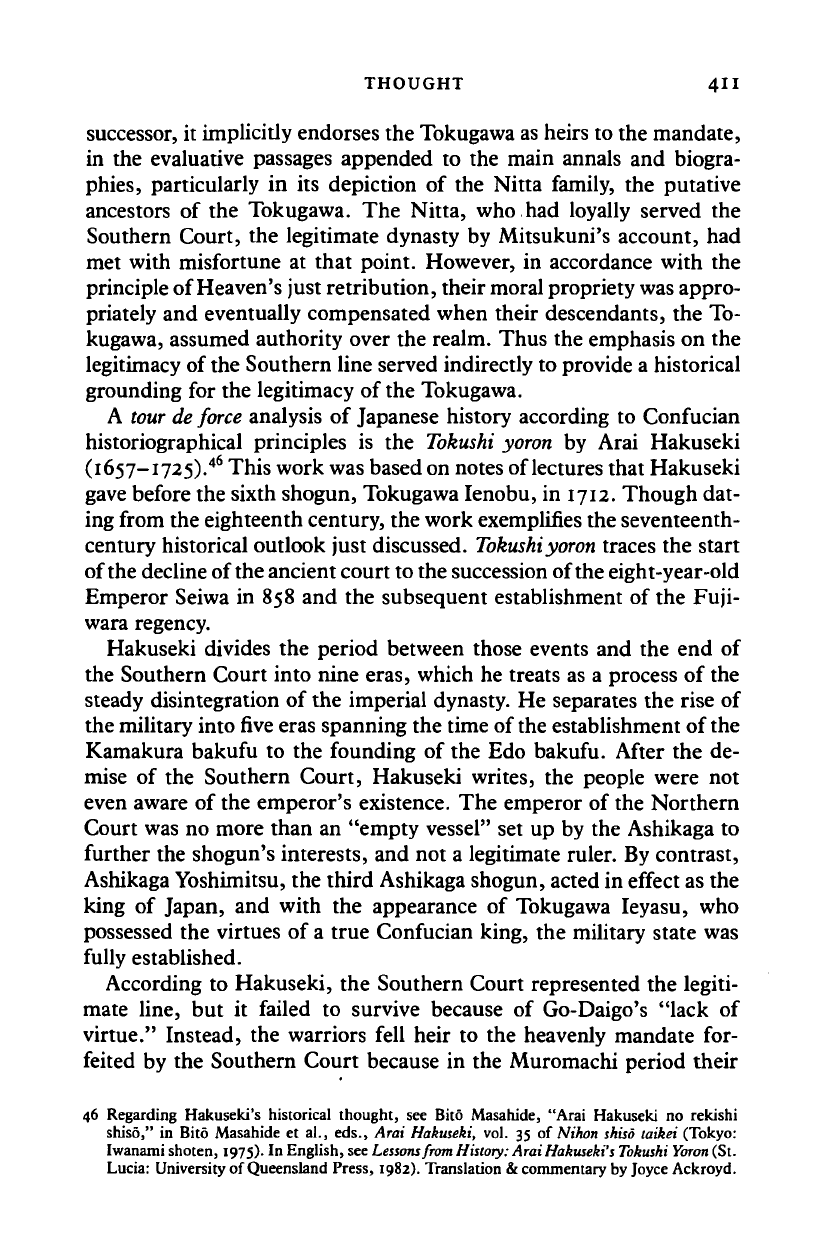
THOUGHT 411
successor, it implicitly endorses the Tokugawa as heirs to the mandate,
in the evaluative passages appended to the main annals and biogra-
phies,
particularly in its depiction of the Nitta family, the putative
ancestors of the Tokugawa. The Nitta, who.had loyally served the
Southern Court, the legitimate dynasty by Mitsukuni's account, had
met with misfortune at that point. However, in accordance with the
principle of Heaven's just retribution, their moral propriety
was
appro-
priately and eventually compensated when their descendants, the To-
kugawa, assumed authority over the realm. Thus the emphasis on the
legitimacy of
the
Southern line served indirectly to provide a historical
grounding for the legitimacy of the Tokugawa.
A
tour de force
analysis of Japanese history according to Confucian
historiographical principles is the
Tokushi yoron
by Arai Hakuseki
(1657-1725).
46
This work was based on notes of lectures that Hakuseki
gave before the sixth shogun, Tokugawa Ienobu, in 1712. Though dat-
ing from the eighteenth century, the work exemplifies the seventeenth-
century historical outlook just discussed. Tokushi
yoron
traces the start
of the decline of the ancient court to the succession of the eight-year-old
Emperor Seiwa in 858 and the subsequent establishment of the Fuji-
wara regency.
Hakuseki divides the period between those events and the end of
the Southern Court into nine eras, which he treats as a process of the
steady disintegration of the imperial dynasty. He separates the rise of
the military into
five
eras spanning the time of the establishment of the
Kamakura bakufu to the founding of the Edo bakufu. After the de-
mise of the Southern Court, Hakuseki writes, the people were not
even aware of the emperor's existence. The emperor of the Northern
Court was no more than an "empty vessel" set up by the Ashikaga to
further the shogun's interests, and not a legitimate ruler. By contrast,
Ashikaga Yoshimitsu, the third Ashikaga shogun, acted in effect as the
king of Japan, and with the appearance of Tokugawa Ieyasu, who
possessed the virtues of a true Confucian king, the military state was
fully established.
According to Hakuseki, the Southern Court represented the legiti-
mate line, but it failed to survive because of Go-Daigo's "lack of
virtue." Instead, the warriors fell heir to the heavenly mandate for-
feited by the Southern Court because in the Muromachi period their
46 Regarding Hakuseki's historical thought, see Bitd Masahide, "Arai Hakuseki no rekishi
shiso,"
in Bitd Masahide et al., eds., Arai Hakuseki, vol. 35 of Nikon shiso taikei (Tokyo:
Iwanami shoten, 1975). In English, see Lessons from History: Arai Hakuseki's Tokushi Yoron(Sl.
Lucia: University of Queensland Press, 1982). Translation & commentary by Joyce Ackroyd.
Cambridge Histories Online © Cambridge University Press, 2008
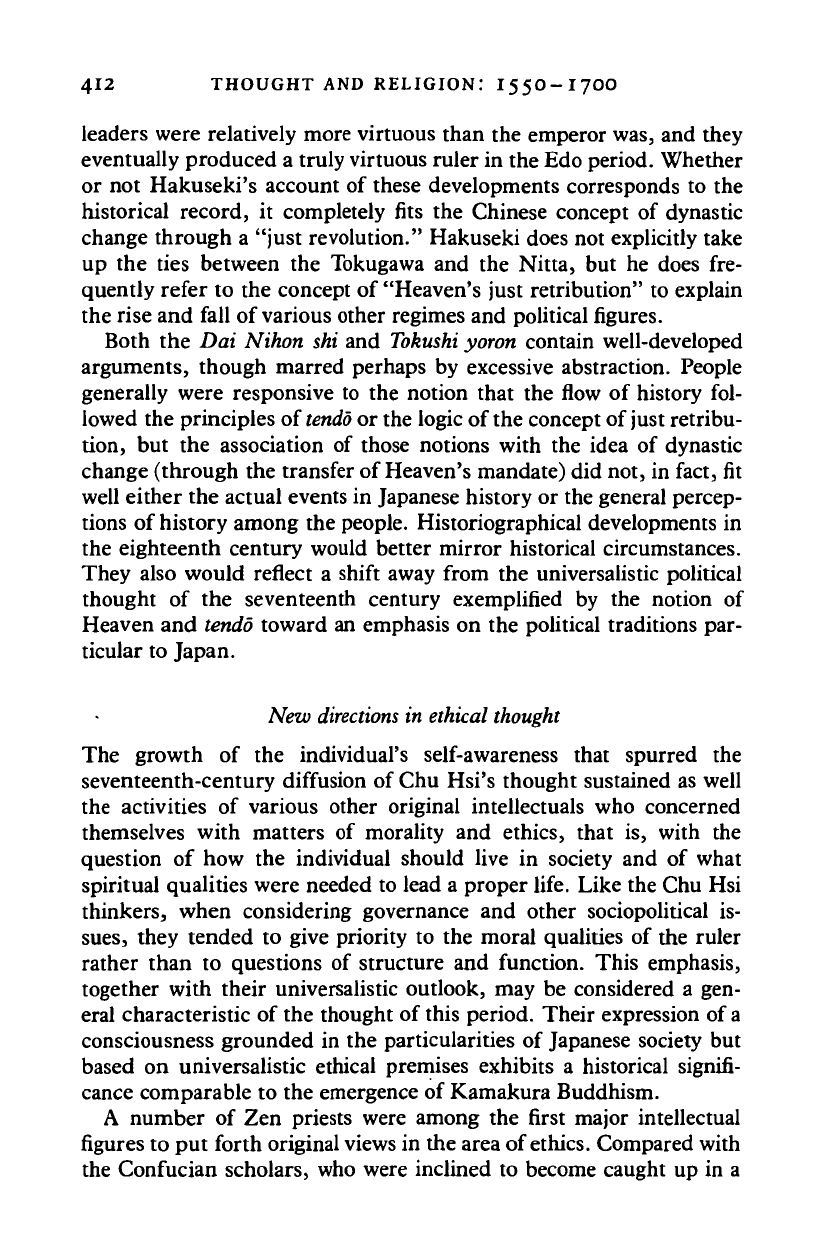
412 THOUGHT AND RELIGION: I55O-I7OO
leaders were relatively more virtuous than the emperor was, and they
eventually produced a truly virtuous ruler in the Edo period. Whether
or not Hakuseki's account of these developments corresponds to the
historical record, it completely fits the Chinese concept of dynastic
change through a "just revolution." Hakuseki does not explicitly take
up the ties between the Tokugawa and the Nitta, but he does fre-
quently refer to the concept of "Heaven's just retribution" to explain
the rise and fall of various other regimes and political figures.
Both the Dai Nihon shi and
Tokushi yoron
contain well-developed
arguments, though marred perhaps by excessive abstraction. People
generally were responsive to the notion that the flow of history fol-
lowed the principles of
tendo
or the logic of the concept of just retribu-
tion, but the association of those notions with the idea of dynastic
change (through the transfer of Heaven's mandate) did not, in fact, fit
well either the actual events in Japanese history or the general percep-
tions of history among the people. Historiographical developments in
the eighteenth century would better mirror historical circumstances.
They also would reflect a shift away from the universalistic political
thought of the seventeenth century exemplified by the notion of
Heaven and
tendo
toward an emphasis on the political traditions par-
ticular to Japan.
New
directions
in ethical thought
The growth of the individual's self-awareness that spurred the
seventeenth-century diffusion of Chu Hsi's thought sustained as well
the activities of various other original intellectuals who concerned
themselves with matters of morality and ethics, that is, with the
question of how the individual should live in society and of what
spiritual qualities were needed to lead a proper life. Like the Chu Hsi
thinkers, when considering governance and other sociopolitical is-
sues,
they tended to give priority to the moral qualities of the ruler
rather than to questions of structure and function. This emphasis,
together with their universalistic outlook, may be considered a gen-
eral characteristic of the thought of this period. Their expression of
a
consciousness grounded in the particularities of Japanese society but
based on universalistic ethical premises exhibits a historical signifi-
cance comparable to the emergence of Kamakura Buddhism.
A number of Zen priests were among the first major intellectual
figures to put forth original views in the area of
ethics.
Compared with
the Confucian scholars, who were inclined to become caught up in a
Cambridge Histories Online © Cambridge University Press, 2008
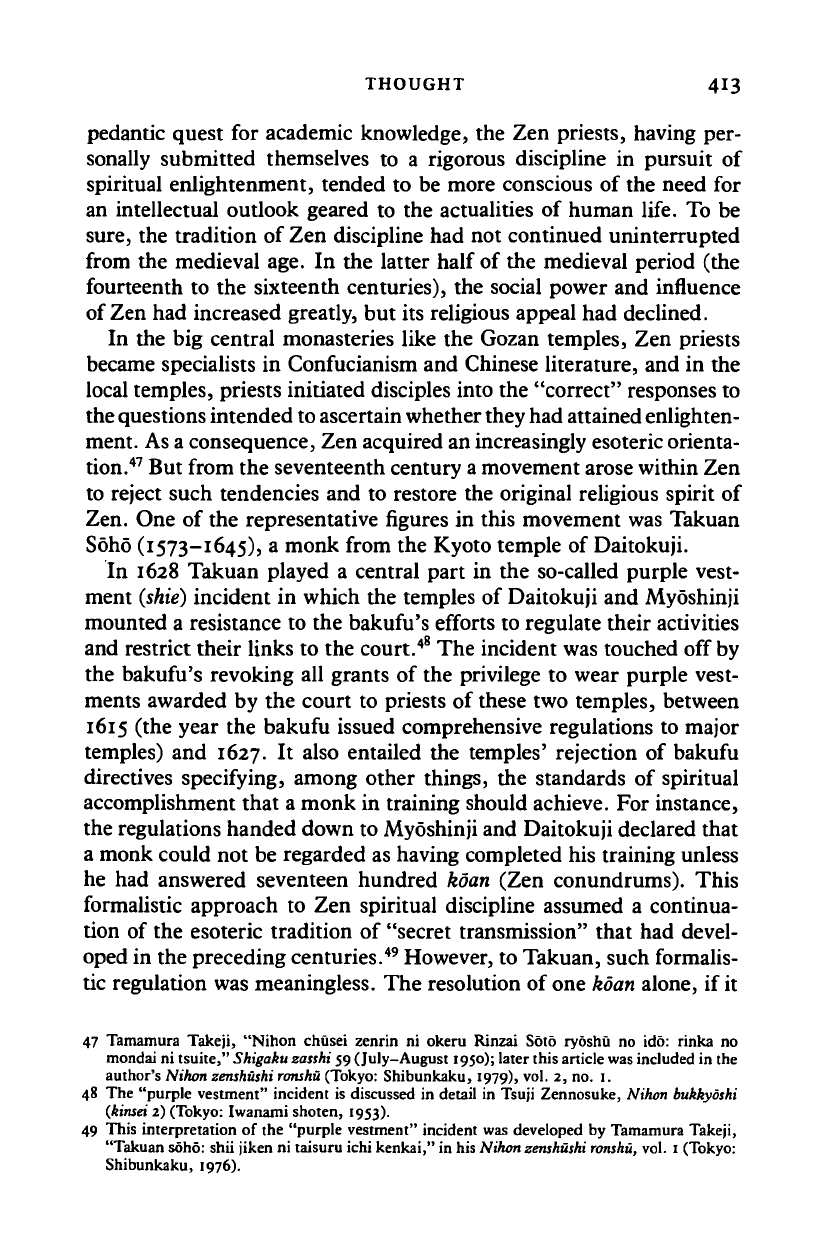
THOUGHT 413
pedantic quest for academic knowledge, the Zen priests, having per-
sonally submitted themselves to a rigorous discipline in pursuit of
spiritual enlightenment, tended to be more conscious of the need for
an intellectual outlook geared to the actualities of human life. To be
sure,
the tradition of Zen discipline had not continued uninterrupted
from the medieval age. In the latter half of the medieval period (the
fourteenth to the sixteenth centuries), the social power and influence
of Zen had increased greatly, but its religious appeal had declined.
In the big central monasteries like the Gozan temples, Zen priests
became specialists in Confucianism and Chinese literature, and in the
local temples, priests initiated disciples into the "correct" responses to
the
questions intended
to
ascertain whether they had attained enlighten-
ment. As a consequence, Zen acquired an increasingly esoteric orienta-
tion.
47
But from the seventeenth century
a
movement arose within Zen
to reject such tendencies and to restore the original religious spirit of
Zen. One of the representative figures in this movement was Takuan
Soho (1573-1645), a monk from the Kyoto temple of Daitokuji.
In 1628 Takuan played a central part in the so-called purple vest-
ment
(shie)
incident in which the temples of Daitokuji and Myoshinji
mounted a resistance to the bakufu's efforts to regulate their activities
and restrict their links to the court.
48
The incident was touched off by
the bakufu's revoking all grants of the privilege to wear purple vest-
ments awarded by the court to priests of these two temples, between
1615 (the year the bakufu issued comprehensive regulations to major
temples) and 1627. It also entailed the temples' rejection of bakufu
directives specifying, among other things, the standards of spiritual
accomplishment that a monk in training should achieve. For instance,
the regulations handed down to Myoshinji and Daitokuji declared that
a monk could not be regarded as having completed his training unless
he had answered seventeen hundred koan (Zen conundrums). This
formalistic approach to Zen spiritual discipline assumed a continua-
tion of the esoteric tradition of "secret transmission" that had devel-
oped in the preceding centuries.
49
However, to Takuan, such formalis-
tic regulation was meaningless. The resolution of one
koan
alone, if it
47 Tamamura Takeji, "Nihon chusei zenrin ni okeru Rinzai Soto ryoshu no ido: rinka no
mondai ni tsuite," Shigaku zatshi 59 (July-August 1950); later this anicle was included in the
author's Nihon
zenshushi ronshu
(Tokyo: Shibunkaku, 1979), vol. 2, no. I.
48 The "purple vestment" incident is discussed in detail in Tsuji Zennosuke, Nihon bukkyoshi
(kinsei
2) (Tokyo: Iwanami shoten, 1953).
49 This interpretation of the "purple vestment" incident was developed by Tamamura Takeji,
"Takuan soho: shii jiken ni taisuru ichi kenkai," in his Nihon
zenshushi
ronshu,
vol. 1 (Tokyo:
Shibunkaku, 1976).
Cambridge Histories Online © Cambridge University Press, 2008
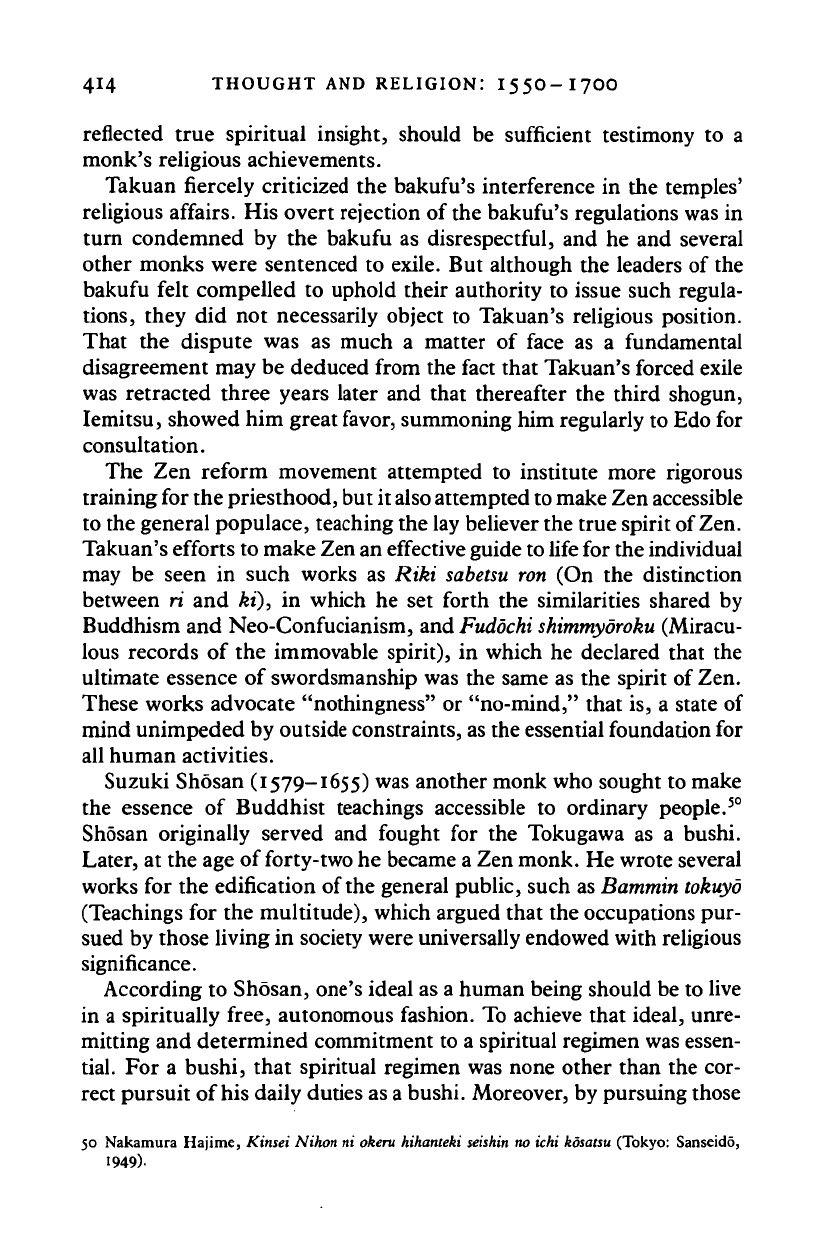
414 THOUGHT AND RELIGION: 155O-I7OO
reflected true spiritual insight, should be sufficient testimony to a
monk's religious achievements.
Takuan fiercely criticized the bakufu's interference in the temples'
religious affairs. His overt rejection of the bakufu's regulations was in
turn condemned by the bakufu as disrespectful, and he and several
other monks were sentenced to exile. But although the leaders of the
bakufu felt compelled to uphold their authority to issue such regula-
tions,
they did not necessarily object to Takuan's religious position.
That the dispute was as much a matter of face as a fundamental
disagreement may be deduced from the fact that Takuan's forced exile
was retracted three years later and that thereafter the third shogun,
Iemitsu, showed him great favor, summoning him regularly to Edo for
consultation.
The Zen reform movement attempted to institute more rigorous
training for the priesthood, but it
also
attempted
to
make Zen accessible
to the general populace, teaching the lay believer the true spirit of Zen.
Takuan's efforts to make Zen an effective guide
to
life for the individual
may be seen in such works as Riki
sabetsu
ron (On the distinction
between ri and ki), in which he set forth the similarities shared by
Buddhism and Neo-Confucianism, and
Fudochi shimmyoroku
(Miracu-
lous records of the immovable spirit), in which he declared that the
ultimate essence of swordsmanship was the same as the spirit of Zen.
These works advocate "nothingness" or "no-mind," that is, a state of
mind unimpeded by outside constraints, as the essential foundation for
all human activities.
Suzuki Shosan (1579-1655) was another monk who sought to make
the essence of Buddhist teachings accessible to ordinary people.
50
Shosan originally served and fought for the Tokugawa as a bushi.
Later, at the age of forty-two he became a Zen monk. He wrote several
works for the edification of the general public, such as Bammin
tokuyo
(Teachings for the multitude), which argued that the occupations pur-
sued by those living in society were universally endowed with religious
significance.
According to Shosan, one's ideal as a human being should be to live
in a spiritually free, autonomous fashion. To achieve that ideal, unre-
mitting and determined commitment to a spiritual regimen was essen-
tial.
For a bushi, that spiritual regimen was none other than the cor-
rect pursuit of
his
daily duties as
a
bushi. Moreover, by pursuing those
50 Nakamura Hajime, Kinsei Nihon ni okeru hihanleki seishin no ichi kdsatsu (Tokyo: Sanseido,
1949)-
Cambridge Histories Online © Cambridge University Press, 2008
